Onion Toxicity in Dogs
Onion Toxicity in Dogs
by Zoya Zaman
Bachelor of Biomedical Science
Deakin University
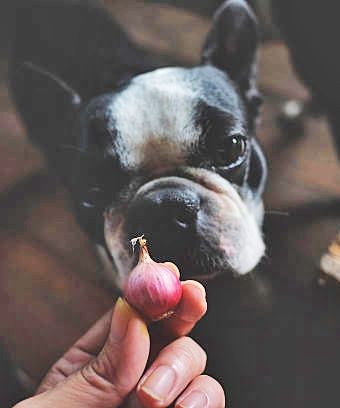 |
| Why is the consumption of onion toxic for dogs? |
Barbeques are popular in Australia and while that leads to a tasty meal for you, the same may not be the case for your canine companion.
Onions contain a toxin called N-propyl disulphide, which makes all portions of the onion plant poisonous to dogs, including the exterior flesh, leaves, and juice. Onions and the rest of the Allium family (garlic, leeks, shallots, and chives) are also toxic to dogs, whether raw or cooked, fried or powdered. In terms of toxicity, garlic and onion powders have been shown to have significantly higher toxicity levels than fresh onions (Kovalkovičová at al., 2009).
Toxic effects can result from the consumption of as little as 100 grams of onion (about the size of a large onion, comparable to the size of a tennis ball) per 20 kilograms of a dog's weight. This suggests that a 25 kilogram dog would only need to consume one medium to large onion (cooked or raw) to reach dangerous toxicity levels. Clinically significant hematologic changes in dogs have been caused by intake of as little as 15 to 30 g per kg of body weight. Animals that consume more than 0.5% of their body weight in onions at once frequently exhibit onion toxicity (Cope, 2005). This is cause for concern as onion particularly barbecued (oily meal) or leftovers would be a tasty snack for a dog. Owners need to take precautionary steps to make sure they do not have access to leftover food scraps in the kitchen or in the bins.
How does the consumption of onion affect a dog’s physiology?
Similar to our blood, blood in dogs consist of red blood cells who function is dedicated to oxygen transport throughout the body, white blood cells that are part of the immune defence and platelets that play a major role in blood clotting (Dean 2005).
A red blood cell (erythrocyte) is a type of blood cell that is produced in the bone marrow and contains a protein called haemoglobin. It is the haemoglobin which binds oxygen and transports it from the lungs to all organs and tissues in the body (Pittman 2011). Red blood cells do not repair themselves if damaged instead, new ones are created by a process called erythropoiesis. Haematopoietic stem cells (immature cells capable of developing into all types of blood cells) give rise to blood cells, which are generated in the red bone marrow. Red blood cells, white blood cells, and platelets can all be formed from haematopoietic stem cells. Onion toxicity targets the red blood cells. Onion contains a substance called N-propyl disulphide and this substances causes the red blood cells to lyse (rupture). This lowers the number of red blood cells circulating in the blood resulting in a condition known as anaemia (lower than normal oxygen levels in the blood). Red blood cells can be harmed by a relatively high dosage (600-800g) taken all at once or spaced out over a few days. This can result in haemolytic anaemia and the formation of Heinz bodies in erythrocytes (Kovalkovičová at al., 2009).
In humans, it is estimated to be 200-300 million molecules of haemoglobin (Hb) per red blood cell. Each haemoglobin molecule has a tetrahedral 3D structure with four haem (immature haemoglobin) groups surrounding a globin (protein) group (Figure 1). Haem is made up of a ringlike organic substance called a porphyrin to which an iron atom is linked. As blood flows between the lungs and the tissues, oxygen binds to the haem groups (Figure 2). Each molecule of haemoglobin has four haem groups, allowing each molecule of haemoglobin to bind to four molecules of oxygen (Pittman 2011).
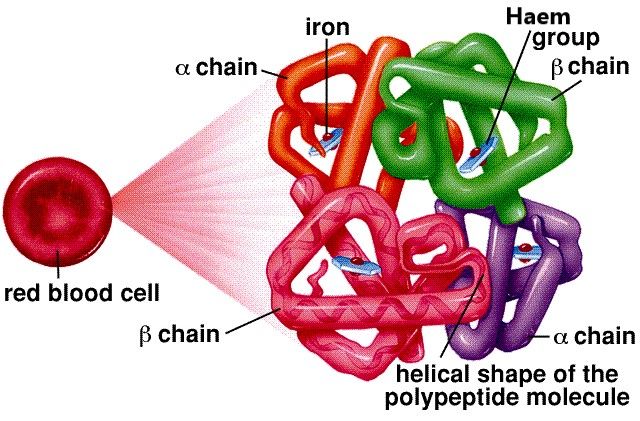 |
Figure 1: Structure of a haemoglobin molecule inside a red blood cell. The molecule consists of four different polypeptide (protein) chains, each containing a haem group. |
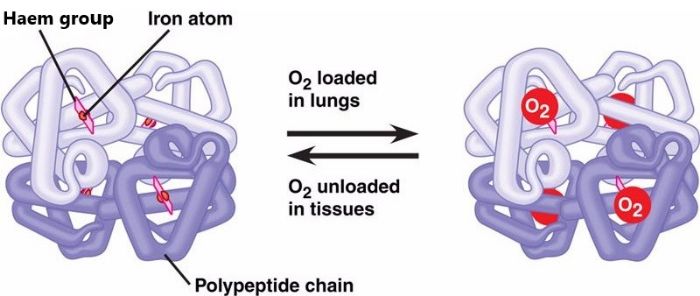 |
Figure 2: Structure of haemoglobin with and without oxygen atoms. |
Low oxygen levels in the blood trigger the process of erythropoiesis, or the formation of new red blood cells, as depicted in Figure 3 . The kidneys act as a sensor organ that determines oxygen levels in the blood. If levels are low, erythropoietin is released from the kidneys. This hormone travels via the blood to the bone marrow where it stimulates the release of erythropoietin when low oxygen levels are detected. Erythropoietin promotes red bone marrow to produce red blood cells. With the help of iron, copper and vitamin B12, new red blood cells are successfully produced from the bone marrow. Oxygen levels in the blood and tissues rise as more red blood cells enter the circulation. The kidneys decrease the release of erythropoietin when they detect an increase in blood oxygen levels. As a result, the formation of red blood cells declines. The numbers of these cells are maintained by a continuous balance of production and destruction of the red cells (Bailey 2021).
---erythropoiesis---zoya.png) |
|
Figure 3: The normal erythropoiesis cycle alongside haemolytic anaemia resulting from onion toxicity. |
When the onion toxin N-propyl disulphide enters a dog’s system, it targets the red blood cells and destroys them faster than they can be produced, resulting in haemolytic anaemia. Normal canine red blood cells survive on average 110-120 days and when they are damaged as occurs in onion poisoning, they are destroyed faster than they can be produced. This results in reduced levels of oxygen carriage by the blood. Figure 3 indicates the disrupted erythropoiesis cycle as onion poisoning keeps the levels of red blood cells low so even though erythropoiesis is occurring, destruction of red blood cells occurs at a faster rate than their production.
When N-propyl disulphide enters a dog’s bloodstream, it causes the oxidative damage resulting in the rupture of red blood cells. When the cells rupture the haemoglobin is dispersed and oxygen transport is compromised.
Figure 4 displays both healthy red blood cells and red blood cells indicated by arrows that are affected by haemolytic anaemia for comparison. Notice that the affected red blood cells have lost their typical, biconcave disc shape to a more irregular form. Their natural, flexible biconcave disc structure aids in increasing the surface area-to-volume ratio. This makes it easier for oxygen and carbon dioxide to diffuse across red blood cells to other parts of the body and allows the red blood cells to squeeze through the narrow capillaries in the organs (Bailey 2021). However, their damaged structure makes the red blood cells inefficient in carrying and transporting oxygen throughout the bloodstream and are more likely to rupture.
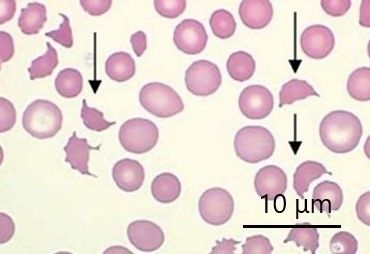 |
|
Figure 4: 100x magnification blood smear of a canine patient with haemolytic anaemia. Red blood cells indicated by arrows are affected by haemolysis |
As a result, the red blood cells rupture or haemolyse (Kovalkovičová et al., 2009). That causes haemolytic anaemia which decreases the number of red blood cells in the dog's bloodstream, ultimately leading to oxygen insufficiency in the organs. N-propyl disulphide may also mislead your dog's immune system into believing the red blood cells to which it is linked are invaders because exposure to onions results in the presence of Heinz bodies in the red blood cells (Yamato 2018). Heinz bodies are a combination of broken down, precipitated haemoglobin within red blood cells that form because of damage to haemoglobin. It is due to N-propyl disulphide which acts by reducing the activity of an enzyme found in the red blood cells (glucose 6 phosphate dehydrogenase); thereby disrupting regeneration of reduced glutathione (antioxidant) needed to prevent oxidative denaturation of haemoglobin (Tang et al., 2008).
When haemoglobin denatures (breaks down) it precipitates (forms a solid) on the surface of the red blood cells (this is what is called the Heinz bodies) and it is the Heinze bodies that triggers the lysis (rupturing) of the cells.
In Figure 5 the arrows indicate Heinz bodies in canine blood as a result of onion toxicity. They are dense, round granules at the surface of red blood cells. They result from oxidant injury to the cells, causing them to rupture.
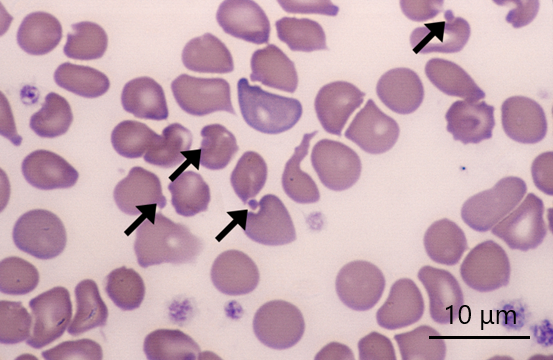 |
|
Figure 5: 100x magnification of blood smear of a canine. The arrows indicate Heinz bodies attached to red blood cells.
|
Symptoms to watch out for if your dog has ingested onions :
- Lethargy/weakness/fainting
- Decreased appetite
- Pale gums
- Reddish urine
- Vomiting
- Elevated heart rate
If your dog has consumed onion, then immediately seek veterinary advice. Indication of onion poisoning include haemolytic anaemia or the presence of Heinz bodies on a blood smear along with a recent history of exposure to onions.
Prevention is the best option for onion poisoning so take steps to prevent your dog from consuming onions or anything else from the Allium family (garlic, leeks, shallots, and chives) in any amount. Be watchful of your pets during events such as a barbeque and store onions in places that are out of their reach such as high pantry shelves with closed doors. If your pet has eaten onions or you suspect they have, contact your local vet immediately or your closest Animal Emergency Centre.
Acknowledgements
Thank you to Emeritus Prof Brian Corbitt and Dr Steven Holloway (BVSc MVS PhD MACVSc Dipl. ACVIM) for valuable comments on the article.
References
American Society of Hematology (ASH Foundation) (2022). Accessed from: https://www.hematology.org/education/patients/blood-basics
Animal Emergency Service hospital: https://animalemergencyservice.com.au/contact-us/
Bailey R.(2021) Red Blood Cells (Erythrocytes). Accessed from https://www.thoughtco.com/red-blood-cells-373487
BetterHealth (2019) ‘Blood and blood vessels’, Anaemia.
Britannica T, Editors of Encyclopaedia (2020). hemoglobin. Encyclopedia Britannica. https://www.britannica.com/science/hemoglobin
Cells and Smears, Veterinary Clinical Pathology Digital Database (2017) ‘Heinz Bodies’. Accessed from: https://vetclinpathimages.com/2017/12/11/heinz-bodies/
Cope RB (2005) ‘Allium species poisoning in dogs and cats’, Vet Med 562–566.
Dean L (2005) ‘Blood Groups and Red Cell Antigens Bethesda (MD): National Center for Biotechnology Information (US), Chapter 1’, Blood and the cells it contains. Accessed from: https://www.ncbi.nlm.nih.gov/books/NBK2263/
Dennis D, Drouillard BS, Vesell MD, Elliot S, Dvorchik and Barry H (1978) ‘Studies on theobromine disposition in normal subjects; Alterations induced by dietary abstention from or exposure to methylxanthines’, Clinical Pharmacology & Therapeutics, 23, doi: 10.1002/cpt1978233296
Frontier Veterinary Hospital (2013), Onion & Garlic Poisoning.
Gwaltney-Brant SM (2021) University of Illinois, ‘Allium spp Toxicosis in Animals’. Accessed from: https://www.msdvetmanual.com/toxicology/food-hazards/allium-spp-toxicosis-in-animals
Kovalkovičová N, Sutiaková I, Pistl J and Sutiak V (2009) ‘Some food toxic for pets’ Interdisciplinary toxicology, 2(3), 169–176, https://doi.org/10.2478/v10102-009-0012-4
Pittman RN (2011) Regulation of Tissue Oxygenation, Virginia Commonwealth University, https://doi.org/10.4199/C00029ED1V01Y201103ISP017
Tang X, Xia Z and Yu J (2008) ‘An experimental study of hemolysis induced by onion (Allium cepa) poisoning in dogs’ Journal of veterinary pharmacology and therapeutics, 31(2), 143–149, https://doi.org/10.1111/j.1365-2885.2007.00930.x
Yamato O, Tsuneyoshi T, Ushijima M, Jikihara H and Yabuki A (2018) ‘Safety and efficacy of aged garlic extract in dogs: upregulation of the nuclear factor erythroid 2-related factor 2 (Nrf2) signaling pathway and Nrf2-regulated phase II antioxidant enzymes’, BMC veterinary research, 14(1), 373, https://doi.org/10.1186/s12917-018-1699-2
Contact Details
Secretary: L Brodie Liaison Officer: A FullerMelbourne, VIC, Australia
Email : [email protected]
